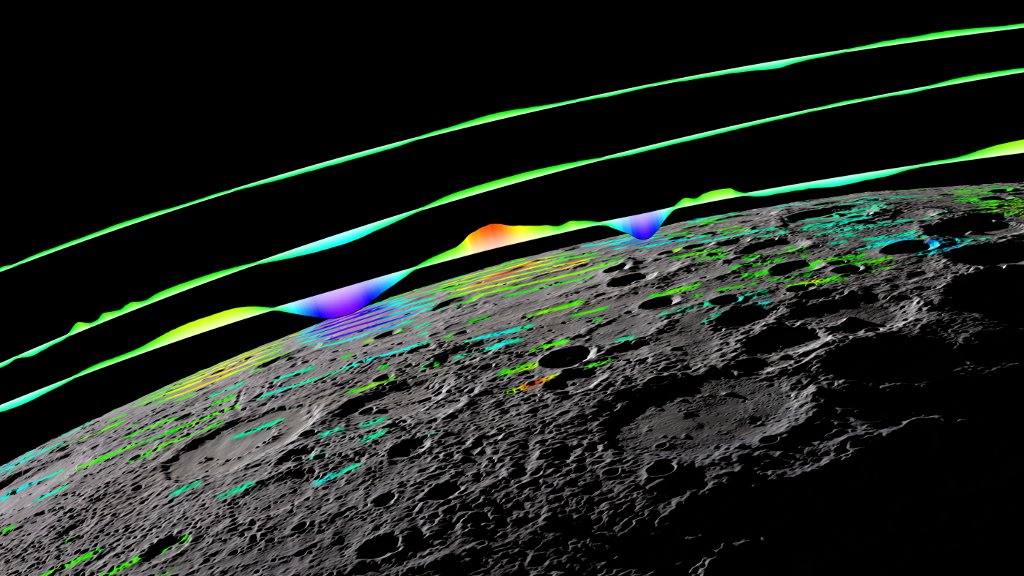Planets and Moons
ID: 4312

Its maneuvering fuel completely spent, the MESSENGER mission to Mercury ended dramatically on April 30, 2015 when the spacecraft impacted the planet's surface, precisely as planned. In the final months of the mission, the altitude of the near point (periapsis) of its elliptical orbit gradually declined, improving the sensitivity and spatial resolution of some of the spacecraft's instruments.
One of those instruments, the magnetometer, detected signs of the magnetism locked into the rocks at the surface, a fossil remnant of the global magnetic field early in Mercury's history. The magnetic signature was frozen into the surface rocks as they cooled and solidified less than a billion years after the planet formed. MESSENGER's detection of this signature is the first direct evidence that Mercury had a magnetic field 3.7 to 3.9 billion years ago. Of the four inner rocky planets, only Mercury and Earth have a global magnetic field generated by a fluid metallic core.
The image shows magnetometer measurements during three orbits at different altitudes. At higher altitudes, the surface magnetism isn't seen, but as the altitude drops, the surface signal gets stronger, confirming that the signal is coming from magnetized rocks in the planet's crust.
Most of the data seen here crosses a region known as Suisei Planitia, a large, relatively smooth feature centered at roughly 60°N, 150°W. Red and orange indicate field lines pointing away from the planet, while blue and purple show field lines pointing into the planet. Colored stripes on the planet's surface show low-altitude measurements from many different orbital passes.
Measuring Mercury's Magnetism

One of those instruments, the magnetometer, detected signs of the magnetism locked into the rocks at the surface, a fossil remnant of the global magnetic field early in Mercury's history. The magnetic signature was frozen into the surface rocks as they cooled and solidified less than a billion years after the planet formed. MESSENGER's detection of this signature is the first direct evidence that Mercury had a magnetic field 3.7 to 3.9 billion years ago. Of the four inner rocky planets, only Mercury and Earth have a global magnetic field generated by a fluid metallic core.
The image shows magnetometer measurements during three orbits at different altitudes. At higher altitudes, the surface magnetism isn't seen, but as the altitude drops, the surface signal gets stronger, confirming that the signal is coming from magnetized rocks in the planet's crust.
Most of the data seen here crosses a region known as Suisei Planitia, a large, relatively smooth feature centered at roughly 60°N, 150°W. Red and orange indicate field lines pointing away from the planet, while blue and purple show field lines pointing into the planet. Colored stripes on the planet's surface show low-altitude measurements from many different orbital passes.
For More Information
Visualization Credits
Ernie Wright (USRA): Lead Visualizer
Catherine L. Johnson (University of British Columbia): Scientist
Gregory A. Neumann (NASA/GSFC): Scientist
Catherine L. Johnson (University of British Columbia): Scientist
Gregory A. Neumann (NASA/GSFC): Scientist
Please give credit for this item to:
NASA's Scientific Visualization Studio
NASA's Scientific Visualization Studio
Science Paper:
C.L. Johnson et al., Low-altitude magnetic field measurements by MESSENGER reveal Mercury's ancient crustal field, Science vol. 348 no. 6237 (22 May 2015), pp. 892-895
Short URL to share this page:
https://svs.gsfc.nasa.gov/4312
Mission:
MESSENGER: Mercury, Surface, Space Environment, Geochemistry and Ranging
Data Used:
Note: While we identify the data sets used in these visualizations, we do not store any further details nor the data sets themselves on our site.
Keywords:
SVS >> Magnetic Fields
SVS >> Mercury
NASA Science >> Planets and Moons
SVS >> Magnetometer
SVS >> MESSENGER
C.L. Johnson et al., Low-altitude magnetic field measurements by MESSENGER reveal Mercury's ancient crustal field, Science vol. 348 no. 6237 (22 May 2015), pp. 892-895
Short URL to share this page:
https://svs.gsfc.nasa.gov/4312
Mission:
MESSENGER: Mercury, Surface, Space Environment, Geochemistry and Ranging
Data Used:
MESSENGER/MDIS/Global Mosaic
Mosaic - JHUAPLMESSENGER/MDIS/Global DTM
ModelMESSENGER/Magnetometer/High-pass Filtered Radial Magnetic Field also referred to as: HPF Radial Field
Observed Data - Jul 2014 - Apr 2015Keywords:
SVS >> Magnetic Fields
SVS >> Mercury
NASA Science >> Planets and Moons
SVS >> Magnetometer
SVS >> MESSENGER











